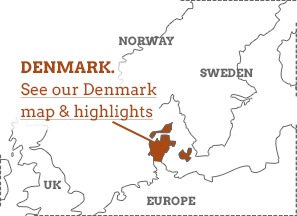Denmark travel guide

The Danes tend to be modest by nature, but they have plenty to boast about. Blessed with a society that sets great store by economic equality, personal freedom and loyal relationships, Denmark beat every other country in the world to the top spot in the UN World Happiness Report, published in 2013. With all those good vibes buzzing around, you can’t help but smile, too.


Where else but Denmark can you find such an appealing blend of originality, eco-awareness and contemporary style?![]()

In this maritime nation of islands, bridges and ferries, renewable energy and sustainable living sit high on the public agenda, making Denmark a great choice for a green vacation. Copenhagen, the attractive capital, is small enough to feel cosy – a favourite Danish quality – and is as enjoyable to visit as to live in. It’s also a great point from which to explore, with a well-crafted web of bike, train and ferry routes leading to a hinterland dotted with Viking remains, medieval cottages, palatial castles, organic farms and gloriously wild beaches.
Is/Isn't...
Denmark is...
one of the most environmentally conscious and contented countries in the world
Denmark isn't...
Belgium, Holland, Norway or Sweden - it's quietly proud of its identity
Food, shopping & people
Eating & drinking in Denmark
Copenhagen has more than a dozen Michelin-starred restaurants. The most famous is noma whose chef-patron, René Redzepi, is passionate about foraging.
The Danish word for Danish pastry is actually Wienerbrød – Viennese. The classic lunch is smørrebrød – an open sandwich heaped with salad, remoulade and smoked salmon, shellfish, marinated herring, salami or other treats.
Summer brings luscious strawberries, raspberries, cherries, blackberries and cordials made from hyldeblomst (elderflower) and hyldebaer (elderberry).

If you can’t get (or can’t afford) a table at noma, don’t fret. There are distinctively Danish culinary adventures to be had all over Denmark.![]()

People & language
The Danish language is notoriously difficult for foreigners to master, but you’ll be forgiven if you don’t learn more than a phrase or two during your stay. Local kids learn English at school from the age of six or seven and most are fluent by their teens. It’s only elderly Danes in rural areas who may struggle with an in-depth conversation in English.
Say hi: “Hej!” (pronounced hi) or see you later: “Hej, hej!”
Don’t hesitate to thank people: "Tak”
When hanging out with friends, tell them you’re having a good time by saying isn’t this cosy: “Hvor er det hyggeligt!” (voy er de ooggerlit)
Raise a glass: “Skål!” (skoel)
Don’t hesitate to thank people: "Tak”
When hanging out with friends, tell them you’re having a good time by saying isn’t this cosy: “Hvor er det hyggeligt!” (voy er de ooggerlit)
Raise a glass: “Skål!” (skoel)
Gifts & shopping
Shopping in Denmark can be expensive, but butter cookies, Lakrids (gourmet liquorice) and Fairtrade chocolate make affordable, distinctive treats –try Torvehallerne, the
capital’s fabulous covered market.
Keen to bag a sweater like Sarah Lund’s in The Killing, or the perfect contemporary lamp? You’ll find a primer on Copenhagen’s top shopping districts for fashion, interior design objects, homewares and antiques here.
For details of eco-friendly and Fairtrade shops in Copenhagen, check out Go Green Denmark.
The compact, walkable centers of Aalborg, Aarhus and Odense offer great shopping for Danish glassware, Viking jewellery and mead.
Travel Team
If you'd like to chat about Denmark or need help finding a vacation to suit you we're very happy to help.
1-866-821-6866
Call toll free
Calling from outside the USA

Danes love to talk of hygge, the feeling of contentment that’s brought on by comforts such as candlelight, tasty food and good company.
![]()

How much does it cost?
Smørrebrød in a café – you’ll want two or three: £1.50 (a piece)
Bycyklen smartbike hire in Copenhagen, per hour £2.60
GoBoat solar powered boat hire in Copenhagen, per hour £42
Copenhagen Card covering public transport & attractions for 48hrs: £51
Carlsberg or Tuborg lager in a bar: £5
Bycyklen smartbike hire in Copenhagen, per hour £2.60
GoBoat solar powered boat hire in Copenhagen, per hour £42
Copenhagen Card covering public transport & attractions for 48hrs: £51
Carlsberg or Tuborg lager in a bar: £5
A brief history of Denmark
There’s evidence that people have lived in Denmark for at least 12,000 years – the earliest remains date to the period shortly after the glaciers retreated at the end of the last Ice Age. The country’s location between the North Sea and the Baltic Sea has made it worth fighting for, and Denmark’s history is peppered with strategic unions and territorial struggles with its neighbours the Swedes, Norwegians and Germans. Read more

Responsible Travel would like to thank the Visit Denmark tourist board for their sponsorship of this guide













